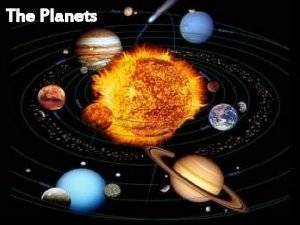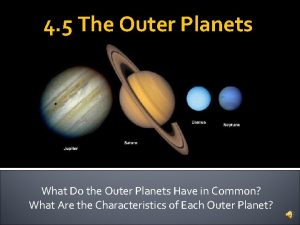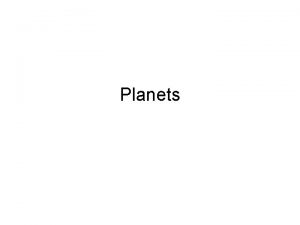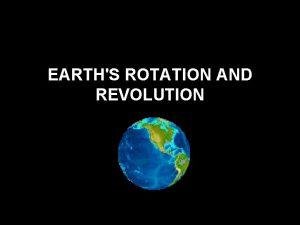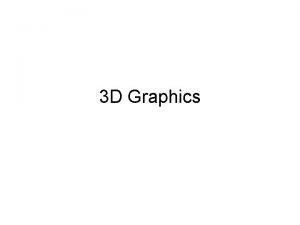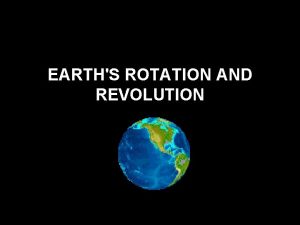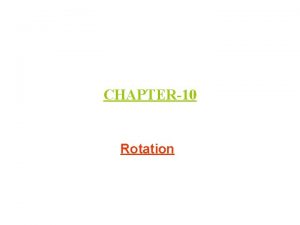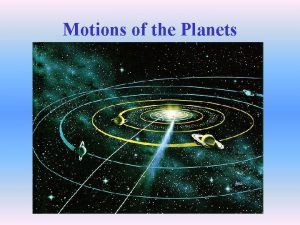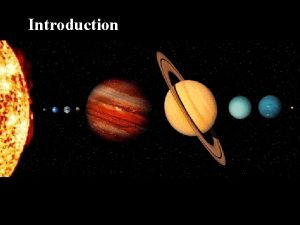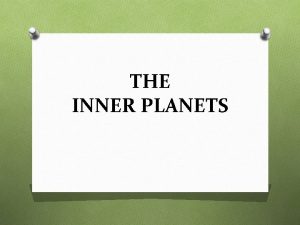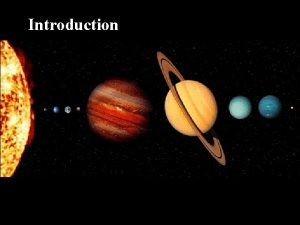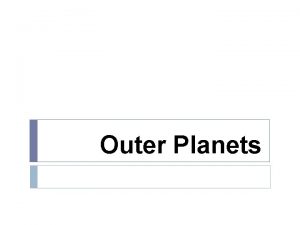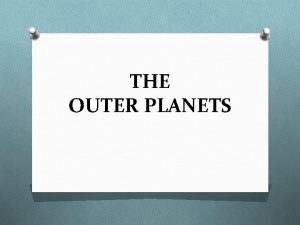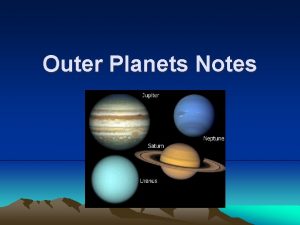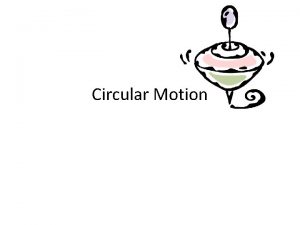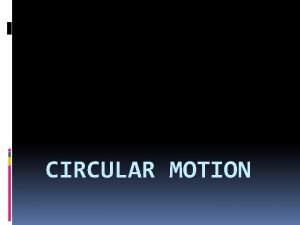The Planets First things first Rotation a circular



















- Slides: 19

The Planets

First things first… Rotation – a circular movement of an object around a center (or point) of rotation; rotation around an axis Sidereal Day – The time it takes for a planet to make one complete rotation on its axis.

Revolution: The action by a celestial body of going round in an orbit or elliptical course. “Copernicus proposed the heliocentric model for the solar system, which had the planets revolving around the Sun instead of the Earth. ”

Back in the olden days… Ptolemy put forth a geocentric, or “Earth-centered” model of the solar system based on his observations and those of his predecessors. His geocentric model showed the Sun and other planets revolving around the Earth, and the universe as a set of nested spheres. Claudius Ptolemaeus (90 -168 A. D. ) This was the main model until…

Nicholas Copernicus, a Polish mathematician, astronomer, physician, classical scholar, translator, artist, Catholic cleric, jurist, governor, military leader, diplomat and economist developed a heliocentric, or “sun-centered” model for the solar system, whereby the planets revolved around the sun in circular paths. His work is regarded as the beginning of modern astronomy, and the defining epiphany that started the Scientific Revolution. His contributions are often referred to as the Copernican Revolution. His theories were later confirmed by… Nicolaus Copernicus (February 19, 1473 – May 24, 1543)

Galileo Galilei, an Italian physicist, mathematician, astronomer, and philosopher who has been called the “father of modern observational astronomy” for his many contributions, including refinements to the refracting telescope with which he confirmed the phases of Venus, the discovery of the four largest satellites of Jupiter, and the observation and analysis of sunspots. Galileo Galilei (15 February 1564 – 8 January 1642) Galileo’s beliefs led to trouble with the Catholic Church, and he was eventually forced to recant heliocentrism. He spent the last years of his life under house arrest on orders of the Roman Inquisition.

Johannes Kepler was a German astronomer who discovered three major laws of planetary motion, conventionally designated as follows: (1) the planets move in elliptical orbits with the Sun at one focus; (2) the time necessary to traverse any arc of a planetary orbit is proportional to the area of the sector between the central body and that arc (the “area law”); and (3) there is an exact relationship between the squares of the planets’ periodic times and the cubes of the radii of their orbits (the “harmonic law”). Kepler’s discoveries turned Nicolaus Copernicus’s Sun-centred system into a dynamic universe, with the Sun actively pushing the planets around in noncircular orbits. And it was Kepler’s notion of a physical astronomy that fixed a new problematic for other important 17 th-century world-system builders, the most famous of whom was Newton. Johannes Kepler (27 December 1571 – 15 November 1630)

Sir Isaac Newton was an English physicist, mathematician, astronomer, natural philosopher, alchemist, and theologian and one of the most influential men in human history. Among many other things, he is credited with describing the Universal Law of Gravitation and the Three Laws of Motion. A 2005 survey of the British Royal Society ranked Newton ahead of even Einstein as having a greater influence on the history of science. January 4 th, 1643 – March 31 st, 1727

Wow! That was a lot of information! Let’s break it down… Ptolemy put forth the idea that the Earth was at the center of the universe and was surrounded by concentric crystal spheres which held the sun and planets. Later, the work Copernicus did showed that Ptolemy’s ideas were incorrect, and that instead of the Earth, it was in fact the Sun that was at the center of the universe and the planets went around the Sun in circular orbits. This heliocentric theory was confirmed by Galileo with his work with that new piece of technology, the telescope. Around this same time, Kepler calculated that the orbits were not circular, as described by Copernicus, but rather were elliptical (oval) in shape. Newton, using the calculus that he co-invented, confirmed this idea of elliptical orbits of the planets. He showed through his calculations that they were held in their orbits by gravity, a concept that he described using his 3 Laws of Motion and his Theory of Universal Gravitation.


The Formation of our Solar System https: //www. youtube. com/watch? v=Uhy 1 fuc. SRQI

How do we know? Observations… Protoplanetary disc forming around HL Tau, a young star at about 1 million years old. This photo was captured by ALMA, the Atacama Large Millimeter/submillimeter Array — a giant telescope consisting of 66 individual antennas, located high up in the Atacama desert in northern Chile.



Take a look at this picture. What do you notice about the orbital speeds of the planets?

But let’s stop and put things in perspective… Push here to compare our Sun and Planets to other objects in the Universe Push here to see how vastly, hugely, mindbogglingly big the Universe is.

The Terrestrial Planets Venus Earth Mars Mercury Color = Yellow Due to clouds of sulfuric acid One rotation takes 243, 01 days and is retrograde, meaning it rotates clockwise (opposite of Earth) Color = Blue Due to oceans of liquid water Color = Red Due to iron oxide in weathered rocks on the surface

The Jovian Planets Jupiter Saturn Uranus Neptune

Just the data, Spock… Look carefully at this chart and notice the differences between the Terrestrials and the Jovians.
 First outer planet
First outer planet What separates the inner and outer planets?
What separates the inner and outer planets? The inner solar system by leslie
The inner solar system by leslie Inner planets and outer planets
Inner planets and outer planets Why do jovian planets have rings
Why do jovian planets have rings Law of planetary motion
Law of planetary motion Calculate the specific rotation of glyceraldehyde
Calculate the specific rotation of glyceraldehyde Principles hair design
Principles hair design What do the 4 outer planets have in common
What do the 4 outer planets have in common Maturity continuum model victories by stephen
Maturity continuum model victories by stephen Habit 3 lesson plans
Habit 3 lesson plans Put first things first meaning
Put first things first meaning Put first things first definition
Put first things first definition Franklin covey maturity continuum
Franklin covey maturity continuum Habit number 3
Habit number 3 Put first things first video
Put first things first video Put first things first activities
Put first things first activities Put first things first
Put first things first Difference between living and non living organisms
Difference between living and non living organisms The 7 life processes of all living things
The 7 life processes of all living things





